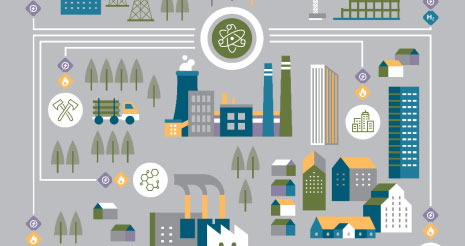A new study, carried out by Simon Wakter at AFRY, investigates in what ways existing nuclear reactors and new and more advanced reactors, can contribute to other parts of the energy sector.
Nuclear reactors fundamentally produce heat, and in Nordic countries, electricity is produced with very low CO2 emissions. But with the climate challenge, a transition is needed and can be used for other purposes, such as in transportation and heavy industry.
As the urgency to decarbonise the energy system rises, Energiforsk's annual nuclear conference 2022, was dedicated the same theme as this report: nuclear beyond electricity. In the conference, international experts gather online to discuss, reflect, and provide insight on the role of nuclear beyond electricity to power sustainable societies. If you missed the live conference or want to see a presentation again, you can view it here. You can also download the presentations from the conference here.
The report evaluates the potential of nuclear energy beyond electricity from a Nordic perspective and with a focus on de-risking the energy transition. The report explores new possibilities, where they are best used, and when we can expect these applications in use. This report presents several examples of nuclear integrated sectors beyond electricity production:
- Direct air capture
- Hydrogen production
- Steel production
- Uses for existing nuclear power plants
Direct air capture
The report explores a novel method of powering direct air capture technology with low-grade nuclear heat, which could offer a cost-competitive and efficient option for capturing carbon emissions. There is broad consensus that Negative Emission Technologies, or NETs, will be needed alongside other measures to keep global average temperature increase below 2 °C and in line with the Paris Agreement.
Hydrogen production
There are many ways to produce low-carbon hydrogen. Steam electrolysis is one of the ways that doesn’t require rare materials. Steam electrolysis offers greater efficiency with less electrical input compared to low-temperature electrolysis and is an attractive option for nuclear hydrogen production.
Steel production
The report analyses steel production to find possible ways of integrating small and advanced reactors into steel production by providing electricity, heat, and hydrogen for direct reduction of iron ore. This initial analysis explores some questions and recommends a focused effort on steel production.
Uses for existing nuclear power plants
New and advanced reactors offer more market opportunities, thanks to higher temperatures and the ability to integrate design considerations already in the early design stages. However, existing reactors also offer opportunities beyond electricity production, for example, industrial electricity, stabilising the power grid, and low-grade heat applications for greenhouses.
Read the full report here. For a brochure of the report, click here.
